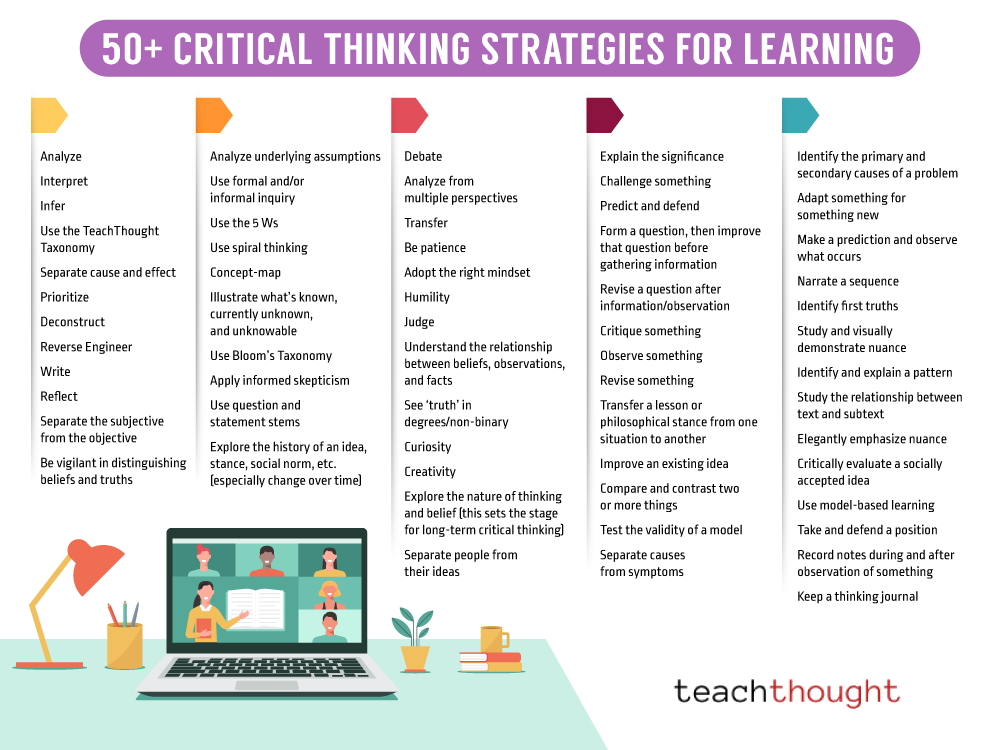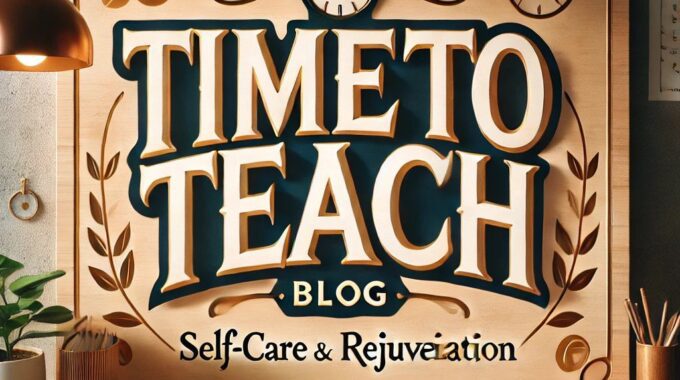As we turn the corner into spring, it’s the perfect time to refresh our teaching…
60 Critical Thinking Strategies For Learning
We believe in thanking our sources! This post was sourced from the following blog/website: https://www.teachthought.com/critical-thinking/critical-thinking-strategies-for-learning/
The following is a new blog post related to education and teaching and relevant to our website visitors. The blog post is not based on the opinions or values of our company but is related to education and teaching, so we wanted to share it with YOU! If you ever have any questions please let us know. Now… on to the post!

Critical thinking is the ongoing application of unbiased, accurate, and ‘good-faith’ analysis, interpretation, contextualizing, and synthesizing multiple data sources and cognitive perspectives in pursuit of understanding.
What are the 7 critical thinking strategies? Someone emailed me recently asking that question and I immediately wondered how many more than seven there were. 27? 77?
Infinity?
This is a post that’s going to have to be updated over time because do define, clarify, offer tips for and examples of each would be a short book.
But I did create a graphic and list many dozen to start with below (60 for now). I’ve also started adding some thinking for each but, as I mentioned, this will take time because it’s such an ambitious list (kind of like the Types of Questions post I did recently.) So, on with the list.
1. Analyze
One of the more basic critical thinking strategies is ‘analysis’: Identify the parts and see the relationships between those parts and how they contribute to the whole.
2. Interpret
Explain the significance or meaning of a ‘thing’ in a specific content or to a specific audience. Similar to ‘translate’ but (generally) with more cognitive demand.
3. Infer
Draw a reasonable conclusion based on the best available data. This critical thinking strategy is useful almost anywhere–from reading to playing a game to solving a problem in the real-world.
4. Use the Heick Domains Of Cognition Taxonomy
In fact, many of these strategies are built-in to the taxonomy.
5. Separate cause and effect
And concept map it–and maybe even consider prior causes to the most immediate causes and predict future possible effects. For example, if you’re considering an effect (e.g., pollution), you might see one cause being a new industrial factory built near a river or runoff. But you might also consider what enabled or ’caused’ that factory to be built–a zoning change or tax break given by the local government, for example.
6. Prioritize
Prioritizing is an executive neurological function that demands knowledge to then apply critical thinking to or on.
7. Deconstruct
And narrate or annotate the deconstruction. Deconstruct a skyscraper or a cultural movement or school or app. This is somewhere between analysis and reverse engineering.
8. Reverse Engineer
9. Write
Writing (well) is one of the most cognitively demanding things students commonly do. It’s also a wonderful strategy to promote critical thinking–a kind of vehicle to help it develop. Certainly one can write without thinking critically or think critically without writing but when they work together–in the form of a thinking journal, for example–the effects can be compelling.
10. Reflect
Observe and reflect is basic pattern for thought itself. The nature of the reflection, of course, determines if it’s actual a strategy for critical thinking but it’s certainly a worthy addition to this list.
11. Separate the subjective from the objective
And fact from opinion.
12. Be vigilant in distinguishing beliefs and facts or truths
To be able to think critically requires
Dewey described critical thinking as ‘reflective thinking’ (see #10)–the “active, persistent and careful consideration of any belief or supposed form of knowledge in the light of the grounds that support it, and the further conclusions to which it tends.” (Dewey 1910: 6; 1933: 9) It’s clear that to be able to consistently do this requires one to separate beliefs (which are personal and fluid) and knowledge (which is more universal and less fluid–though the depth and nature of knowledge and understanding can change over time).
13. Link and Connect
This is somewhere between analysis and concept mapping, but seeing the relationship between things–ideas, trends, opportunities, problems–is not only useful as a strategy but is how the brain learns: by making connections.
14. Use formal and/or informal inquiry
15. Use the 5 Ws
A flexible strategy for inquiry and thought, the 5 Ws provides a kind of starting point for ongoing thought: who, what, where, why, and when.
16. Use spiral thinking
17. Concept map
18. Illustrate what’s known, currently unknown, and unknowable
This is part analysis, part epistemology.
19. Use Bloom’s Taxonomy
20. Apply informed skepticism
21. Use question and statement stems
22. Explore the history of an idea, stance, social norm, etc.
Especially change over time.
23. Debate
24. Analyze from multiple perspectives
25. Transfer
26. Patience
27. Adopt the right mindset
28. Humility
29. Judge
30. Study relationships
Between beliefs, observations, and facts, for example.
31. See ‘truth’ in degrees/non-binary
32. Improve something
33. Curiosity
Similar to inquiry but more a cause of inquiry than a strategy itself. Maybe. Kind of.
34. Creativity
35. Explore the nature of thinking and belief
This sets the stage for long-term critical thinking.
36. Separate people from their ideas
This isn’t necessarily a pure critical thinking strategy but it can reduce bias and encourage rationality and objective analysis.
37. Making some abstract concrete or something concrete abstract
38. Challenge something
39. Predict and defend
40. Form a question, then improve that question before gathering information
41. Revise a question after information/observation
42. Critique something
43. Observe something
While not actually ‘critical thinking,’ critical thinking rarely happens without it. It’s one (of many) fuels for ‘higher-order’ thinking.
44. Revise something
45. Transfer a lesson or philosophical stance from one situation to another
A lesson from nature to the design of a tool or solution to a problem.
46. Compare and contrast two or more things
47. Test the validity of a model
Or even create a basic mathematical model for predicting something–stocks, real-world probabilities, etc.
48. Create an analogy
This helps emphasize relationships, rules, and effects.
49. Adapt something for something new
A new function or audience or application, for example.
50. Identify underlying assumptions
51. Analyze the role of social norms on ‘truth’
Or even the nature of ‘truth’ itself.
52. Narrate a sequence
53. Identify first truths
54. Keep a thinking journal
55. Identify and explain a pattern
56. Study the relationship between text and subtext
Or explicit and implicit.
57. Elegantly emphasize the nuance of something
58. Identify cognitive biases and blindspots
59. Use model-based learning
I’ll provide a model for this soon but I’ve been using it with students for years.
60. Take and defend a position
Similar to debate but it can be one-sided, in writing, on a podcast, or even concept-mapped. It’s a simple strategy: specify a ‘stance’ and defend it with the best possible data and unbiased thinking
60 Critical Thinking Strategies For Learning
The post 60 Critical Thinking Strategies For Learning appeared first on TeachThought.
Time To Teach reviews each blog post by our contributors but if you feel this is a blog post better suited for another page please let us know.
Teachers and Educators are our heroes. We want to thank you for the work you do!
Yours In Education!
Time To Teach

